
Ingham is a small village and civil parish in the English county of Norfolk. It lies close to the village of Stalham, and is about 2 miles (3.2 km) from Sea Palling on the North Sea coast.

Walsingham is a civil parish in North Norfolk, England, famous for its religious shrines in honour of Mary, mother of Jesus. It also contains the ruins of two medieval monastic houses. Walsingham is 27 miles (43 km) northwest of Norwich.

Easton Royal is a village in the civil parish of Easton in Wiltshire, England, about 3 miles (5 km) east of Pewsey and 5 miles (8 km) south of Marlborough. The village was the location of Easton Priory from 1234 to 1536. The village mistakenly gained the Royal suffix in 1838 and the name Easton Royal has been in general use since the 1850s.

Marham is a village and civil parish in the English county of Norfolk, approximate 12 miles (19 km) away from King's Lynn. An RAF station, RAF Marham, is situated nearby at Upper Marham. The village covers an area of 1,485 ha and had a population of 2,951 in 788 households as of the 2001 census, increasing to 3,531 at the 2011 Census.
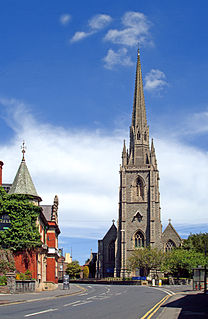
Stapleton is an area in the northeastern suburbs of the city of Bristol, England. The name is colloquially used today to describe the ribbon village along Bell Hill and Park Road in the Frome Valley. It borders Eastville to the South and Begbrook and Frenchay to the North. It comprises an eclectic mix of housing mainly from the Victorian, Edwardian, inter-war and late 20th century periods.

The Trinitarians, formally known as the Order of the Most Holy Trinity and of the Captives, is a mendicant order of the Catholic Church for men founded in Cerfroid, outside Paris, in the late 12th century. From the very outset, a special dedication to the mystery of the Holy Trinity has been a constitutive element of the order's life.
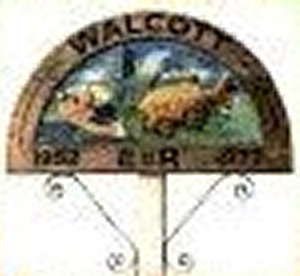
Walcott is a small village and civil parish on the North Norfolk coast in England between Mundesley and Happisburgh. The name is formed from the Anglian word 'walh' and the Anglo-Saxon 'cot' meaning 'cottage, hut, shelter or den'. The village is 19.1 miles (30.7 km) north east of Norwich, 11.9 miles (19.2 km) south east of Cromer and 137 miles (220 km) north east of London. The village lies 5.6 miles (9.0 km) east of the town of North Walsham.

Sir William Calthorpe KB was an English knight and Lord of the Manors of Burnham Thorpe and Ludham in Norfolk. He is on record as High Sheriff of Norfolk and Suffolk in 1442, 1458 and 1464 and 1476.

Sir Miles Stapleton, KG was Lord of the Manor of Ingham, Norfolk and de jure Baron Ingham of Ingham, Norfolk, and Lord of the Manor of Bedale, Yorkshire.
Sir Oliver Ingham was an English knight and landowner who served as a soldier and administrator under King Edward II of England and his successor, King Edward III. He was responsible for the civil government and military defence of the Duchy of Aquitaine during the War of Saint-Sardos and the early part of the Hundred Years' War.
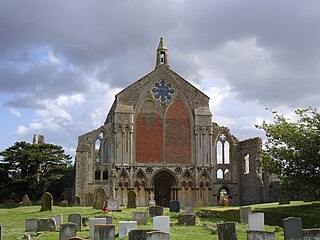
St Mary's Priory, Binham, or Binham Priory, is a ruined Benedictine priory located in the village of Binham in the English county of Norfolk. Today the nave of the much larger priory church has become the Church of St. Mary and the Holy Cross and is still used as a place of worship. The remains of the priory are in the care of English Heritage. The abbey's west face is the first example in England of gothic bar tracery, predating Westminster Abbey by a decade.

The Church of Holy Trinity is an Anglican church on Bell Hill in Stapleton, Bristol, England. It has been designated as a grade II* listed building.
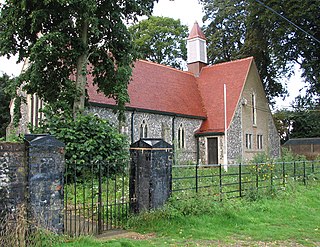
Hempton is a village and a civil parish in the English county of Norfolk. The village is 0.8 miles (1.3 km) south west of Fakenham, 33.9 miles (54.6 km) north west of Norwich and 100 miles (160 km) north east of London. The village straddles the A1065 between Fakenham and Swaffham. The nearest railway station is at Sheringham for the Bittern Line which runs between Sheringham, Cromer and Norwich. The nearest airport is Norwich International Airport.
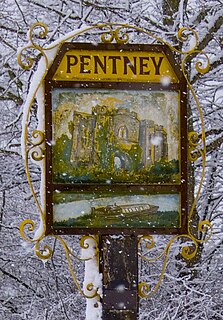
Pentney is a village and civil parish in the English county of Norfolk, located about 8 miles (13 km) south east of King's Lynn placing it about halfway between King's Lynn and Swaffham on the A47 road. It covers an area of 10.39 km2 (4.01 sq mi) and had a population of 387 in 184 households at the 2001 census, increasing to 544 at the 2011 Census. For the purposes of local government, it falls within the district of King's Lynn and West Norfolk. It is in the valley of the River Nar, a tributary of the River Great Ouse.
Totnes Trinitarian Priory, also known as the Trinitarian hospital of Warland was a medieval monastic house in the town of Totnes in Devon, England. It was founded in 1271, and dissolved in 1509.
The Priory of St Nicholas was established at Arundel in West Sussex, England by Roger de Montgomery, earl of Shrewsbury, in 1102, when Gratian, a monk of Sées in Normandy, became first prior. In 1269, the priory granted Master William de Wedon, in return for various gifts, board and lodging, and a room in the priory in which he might conduct a school.
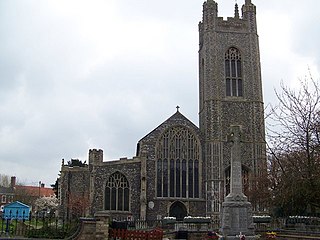
St Mary's Church is a redundant Anglican church in the town of Bungay, Suffolk, England. The church and the ruins of the adjacent priory are recorded in the National Heritage List for England as a designated Grade I listed building, and are under the care of the Churches Conservation Trust. The church stands in the centre of the town on St Mary's Street, the A144 road.

Holy Trinity Church in Ingham, Norfolk, England has been designated as a Grade I listed building by Historic England. The tower dates from the 15th century.















